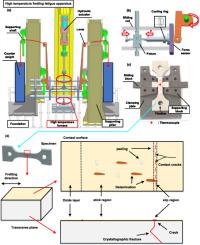当前位置:
X-MOL 学术
›
Int. J. Mech. Sci.
›
论文详情
Our official English website, www.x-mol.net, welcomes your feedback! (Note: you will need to create a separate account there.)
Fretting fatigue damage mechanism of Nickel-based single crystal superalloys at high temperature
International Journal of Mechanical Sciences ( IF 7.3 ) Pub Date : 2020-11-01 , DOI: 10.1016/j.ijmecsci.2020.105894 Shouyi Sun , Lei Li , Kun He , Zhufeng Yue , Weizhu Yang , Zhiyuan Yu
International Journal of Mechanical Sciences ( IF 7.3 ) Pub Date : 2020-11-01 , DOI: 10.1016/j.ijmecsci.2020.105894 Shouyi Sun , Lei Li , Kun He , Zhufeng Yue , Weizhu Yang , Zhiyuan Yu

|
Abstract A novel high temperature fretting fatigue test apparatus was developed to investigate the fretting fatigue mechanism of Nickel-based single crystal (NBSX) superalloys at elevated temperature. The fretting fatigue tests were carried out under 5 loading conditions at 600°C. Results showed that the fretting fatigue life decreased with the increase of axial load and normal load. Metallographic observations revealed that surface peeling, delamination occur at the contact area. Energy dispersive spectrum (EDS) analysis showed that the surface material was oxidized, and the oxides will be compacted onto the contact surface and form a glazed layer. Besides, many micro cracks are observed at the contact surface that are nearly perpendicular to the fretting direction. These micro cracks would either be eliminated due to the large relative displacement or grow into the main crack, which are supposed to be the dominant source of fretting fatigue failure. Multiple fretting fatigue cracks initiate at the contact leading edge area and grow along the (100) plane that is nearly perpendicular to the fretting direction. Then the crack propagation direction will deflect from (100) plane to a series of {111} planes and the specimen eventually failed. The combined effect of fretting wear and crystallographic slip is the cause of fretting fatigue failure.
中文翻译:

镍基单晶高温合金的高温微动疲劳损伤机制
摘要 研制了一种新型高温微动疲劳试验装置,研究了镍基单晶(NBSX)高温合金在高温下的微动疲劳机理。微动疲劳试验是在 600°C 下在 5 个加载条件下进行的。结果表明,微动疲劳寿命随着轴向载荷和法向载荷的增加而降低。金相观察表明,接触区发生表面剥离、分层。能量色散谱(EDS)分析表明,表面材料被氧化,氧化物将压实到接触表面并形成釉层。此外,在几乎垂直于微动方向的接触面上观察到许多微裂纹。这些微裂纹要么由于较大的相对位移而被消除,要么扩展为主裂纹,这被认为是微动疲劳失效的主要来源。多个微动疲劳裂纹始于接触前缘区域,并沿几乎垂直于微动方向的 (100) 平面扩展。然后裂纹扩展方向将从 (100) 平面偏转到一系列 {111} 平面,试样最终失效。微动磨损和晶体滑移的综合作用是微动疲劳失效的原因。然后裂纹扩展方向将从 (100) 平面偏转到一系列 {111} 平面,试样最终失效。微动磨损和晶体滑移的综合作用是微动疲劳失效的原因。然后裂纹扩展方向将从 (100) 平面偏转到一系列 {111} 平面,试样最终失效。微动磨损和晶体滑移的综合作用是微动疲劳失效的原因。
更新日期:2020-11-01
中文翻译:

镍基单晶高温合金的高温微动疲劳损伤机制
摘要 研制了一种新型高温微动疲劳试验装置,研究了镍基单晶(NBSX)高温合金在高温下的微动疲劳机理。微动疲劳试验是在 600°C 下在 5 个加载条件下进行的。结果表明,微动疲劳寿命随着轴向载荷和法向载荷的增加而降低。金相观察表明,接触区发生表面剥离、分层。能量色散谱(EDS)分析表明,表面材料被氧化,氧化物将压实到接触表面并形成釉层。此外,在几乎垂直于微动方向的接触面上观察到许多微裂纹。这些微裂纹要么由于较大的相对位移而被消除,要么扩展为主裂纹,这被认为是微动疲劳失效的主要来源。多个微动疲劳裂纹始于接触前缘区域,并沿几乎垂直于微动方向的 (100) 平面扩展。然后裂纹扩展方向将从 (100) 平面偏转到一系列 {111} 平面,试样最终失效。微动磨损和晶体滑移的综合作用是微动疲劳失效的原因。然后裂纹扩展方向将从 (100) 平面偏转到一系列 {111} 平面,试样最终失效。微动磨损和晶体滑移的综合作用是微动疲劳失效的原因。然后裂纹扩展方向将从 (100) 平面偏转到一系列 {111} 平面,试样最终失效。微动磨损和晶体滑移的综合作用是微动疲劳失效的原因。



























 京公网安备 11010802027423号
京公网安备 11010802027423号